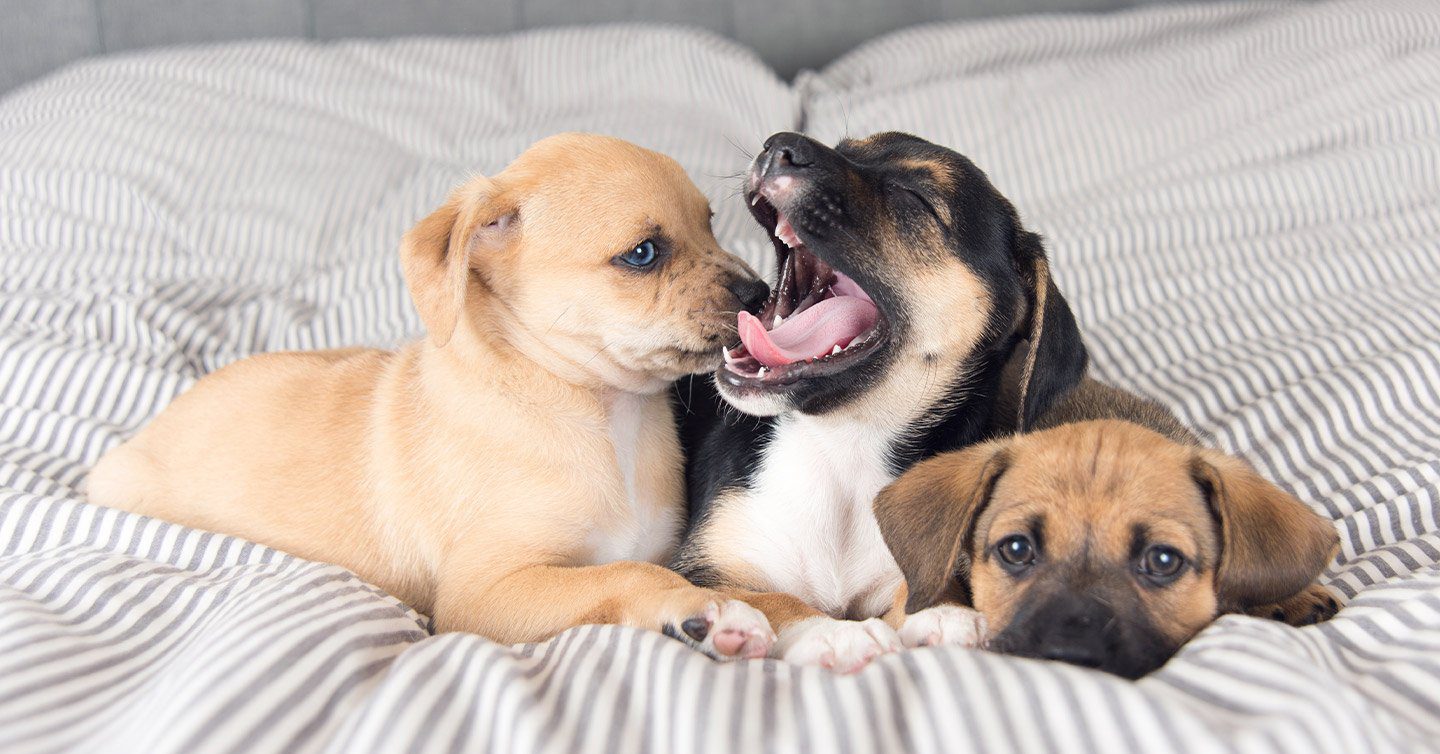You’re getting a puppy? Congratulations on becoming a pawrent! While it’d be remiss to compare raising a puppy to raising a child, there are definite parallels: It requires work, patience, money, and a lot of time. And like raising a child, you’ll be rewarded handsomely with love – albeit your canine companion is much more likely to lick your face in gratitude than your human child would (we hope, anyway).
Puppy parenting, like regular parenting, can be overwhelming. There’s a lot for both of you to learn, and your own efforts should start before you bring your precious pooch home. Luckily for you, we’ve compiled the Ultimate New Puppy Checklist to get you started. From staple supplies, to essentials like pet insurance and a dog DNA test, here’s everything you need to be the best fur baby parent ever.
1. Make sure you’re ready for what a big responsibility a puppy is!
Not to get all mom on you, but a puppy is basically a full-time job, especially in the first few months. Be sure you can give a puppy the care and attention they need before becoming a pet parent.
Even just the everyday stuff requires a lot of effort. New puppies need to be fed three to four times a day and walked or taken outside immediately afterward – and even then, they’ll inevitably have some accidents indoors that you’ll have to clean up. Puppies will also likely wake you up during the night to relieve themselves (which is better than some, who will just leave a mess for you to step in the next morning). Puppies also require quite a bit of socialization and exercise, which can be time-consuming for anyone, especially if you’re juggling work, school, or kids.
Make no mistake. It’s rewarding – and (like most rewarding things) a tall order. If it sounds like a bit more than you can handle, that’s OK! There are plenty of adult dogs in need of homes who would love you unconditionally and require less effort from the outset.
2. Find the right puppy for you.
Some breeds or mixes may be better fits for you than others. Some things to consider when choosing a puppy include:
- Size: If you live in a small studio, you may be better suited to a pug than you are a pitbull.
- Activity level: If you’re active, you want a puppy that can keep up with you, and vice versa. If you’re looking for a binge-watching buddy to accompany you on the couch, be sure the puppy you take home prefers cuddling to cross-country runs.
- Fur or hair type: If getting dog hair on your clothes, furniture, carpets, and car upholstery would drive you crazy, consider a puppy that doesn’t shed. However, know that a low-shedding dog will likely require regular grooming, which can be time-consuming and expensive.
- Allergies: If you or anyone in your home is allergic to dog dander, choose a puppy that’s hypoallergenic.
- Kids under 10: Some breeds – like labs, bull dogs, collies, etc. – are better suited for children than others.
- Volume: How much barking can you tolerate? How loud? Some breeds will be significantly more vocal than others, and it’s up to you whether that’s cute, or will drive you crazy.
- Other pets: Whether you have a cat at home or plan on getting another dog someday, be sure your puppy will be able to acclimate and get along with them.
- Purebred vs. mixed breed: Your local shelter is likely chock-full of rescue puppies, many of which will be mixed breeds. Mixed breed puppies are unique, adorable, and may be less prone to certain health problems than their purebred peers. If you truly want a purebred puppy, do your due diligence in researching breeders to avoid puppy mills.
3. Puppy-proof your home.
Before taking your new puppy home, be sure that “home” is safe and accommodating for your four-legged friend. Similar to child- and baby-proofing a home before you bring the pitter patter of little feet into your life, you’ll want to prepare for the pitter patter of little paws, too. To start:
- You may have to rearrange some of your furniture and decor to give ample room for indoor zooming! Your puppy will need space to play, so make sure to keep anything fragile somewhere they can’t knock it over.
- Until your puppy is adept at dashing up and down stairs, using a gate can keep them safe from dangerous tumbles.
- If you have a yard, be sure it’s fenced. If you have an in-ground swimming pool, fence it or otherwise obstruct it from your puppy’s reach. If you have an above-ground pool, be sure they can’t get to the ladder or steps. Also be sure your puppy can’t access plants that can be toxic to them, like daffodils, that you may have in your garden.
- Stock up on anti-chew spray and give your wires, furniture, shoes, and anything else they may gnaw on (and with a teething puppy, that’s a lot) a good spritz.
- Keep laundry out of your puppy’s reach – especially dryer sheets, which are toxic to dogs.
- Hide shoes, socks, and any other small items that may be within your puppy’s reach and mistaken for a chew toy.
- Put electrical cords and wires out of their reach or sight.
- Move houseplants, many of which can be toxic to pets, out of reach.
- Invest in trash cans with snapping lids (or place them in a hidden cabinet).
- If your puppy sheds, be sure to snag lint rollers, a vacuum, dust mops and/or a rubber broom to clean up loose fur.
- Lock cabinets containing food, medicines, and chemicals.
Not sure how to tell if your puppy can reach something? Get on all fours for a minute to get the dog’s-eye view.
4. Stock up on puppy supplies.
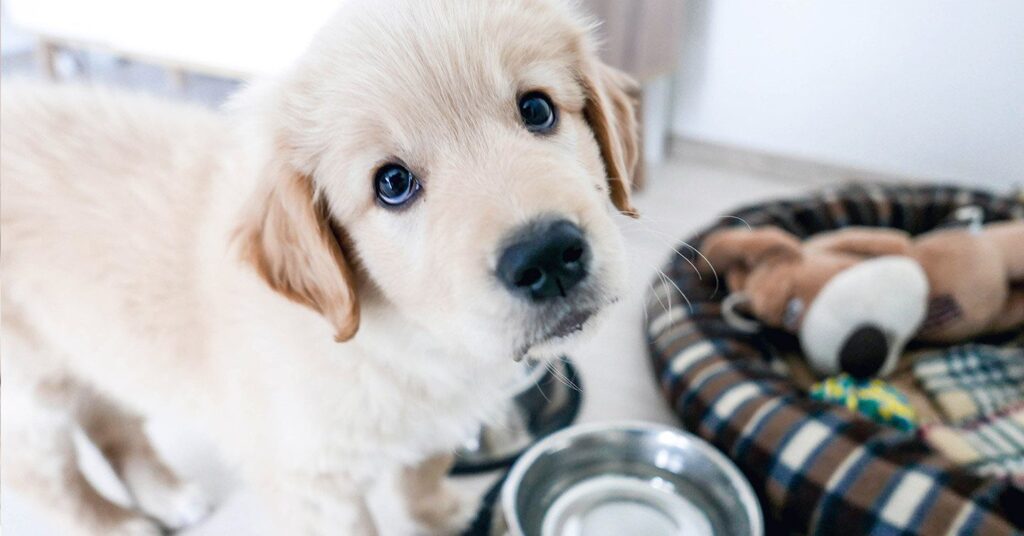
Your new best friend will need some gear before you take them home. Start with the basics for now, and depending on your puppy’s temperament and what they like, you can go to town shopping for extras later:
- Puppy food
- Stainless steel, dishwasher-safe water bowls and food bowls
- Puppy treats, including training treats
- Adjustable collar (since your pup will grow quickly!)
- ID tags with contact info like phone number
- Basic leash
- Long leash for training
- Potty training pads
- Poop bags
- Puppy toothbrush, toothpaste, and dental treats
- Enzyme cleaner for accidents
- Anti-chew spray (you’ll want to spray this on the leash!)
- Grooming supplies (high-quality brush/comb for your puppy’s fur type, plus nail clippers and puppy shampoo)
- Dog bed and dog crate with ample room to grow
- Training clicker
- Baby gate or playpen
- Blankets (if you live in a colder area)
- Puppy toys (one each of squeak, plush, puzzle and chew toys, plus the old classic – a ball!)
5. Do a doggy DNA test.
Once you bring your new pupper home, it’s time to bond and get to know them! While there’s a lot you can learn about your new pet’s tastes, temperament, and intelligence just by spending time with them, there are other invaluable things you can learn now too with a simple swab of the cheek, thanks to recent scientific advancements in animal genetics.
Like human DNA, your pup’s DNA can speak volumes about them. It can uncover your mystery mutt’s unique breed mix, or give you insight into your purebred’s quirky physical traits. It can even identify hereditary or breed-specific conditions your pup could be at risk for in the future.
Aside from indulging your curiosity, your pet’s DNA results can help you be more proactive about their care. For example, if you were to learn your pup was at risk for hip dysplasia, you could work with your vet to start early detection screenings at a young age and make diet and lifestyle changes that could help delay (or even prevent) the onset of the disease. What a game changer!
While there are several dog DNA tests on the market – not all are created equal. So which is the pick of the litter? Pumpkin did the research and recommends Embark’s Breed + Health Kit. Here’s why:
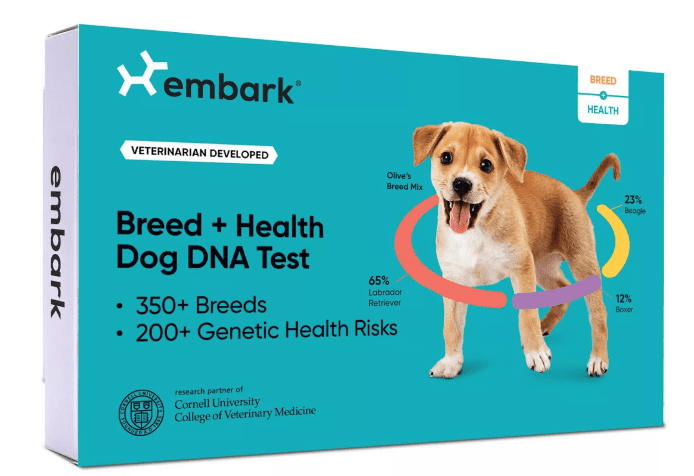
- Developed by one of the world’s leading dog geneticists, Dr. Adam Boyko, in partnership with Cornell University
- Highest-rated dog DNA test on the market
- Most accurate breed identification with 350+ breeds, types & varieties tested
- Tests for over 200+ genetic health risks
- Tests for 20+ physical traits
- Tracks ancestry and family tree back to great grandparents
- Includes the world’s only Canine Relative Finder
- Highly specialized vets & canine geneticists on-staff to answer questions
Use code PUMPKIN at checkout!
6. Invest in pet insurance.
From catastrophic accidents to common illnesses, you can expect to spend about $16,600* on veterinary care over the course of a dog’s life. Add a serious emergency into the mix and it could cost thousands more! If your puppy gets sick or hurt, pet insurance can help cover a large majority of the vet bills for the treatments. Because you should never have to choose between providing the best care for your pet and keeping your finances in check.
“Lots of people remember to buy their puppies beds, bowls and collars, but pet insurance gets forgotten. Pet insurance covers your dog for unexpected medical bills if they become ill, and as proper veterinary care often costs thousands of dollars, it’s worth getting some good coverage,” Dr. Joanna Woodnutt, MRCVS, of The Veterinary Content Company, tells Pumpkin. “My advice is to get it as soon as possible after getting your new dog. This is because most insurance providers will exclude ‘pre-existing conditions’ – in other words, any condition your pet shows signs of before the insurance is taken out, even if they didn’t need treatment. The sooner you get insurance, the less likely it is that you’ll run into problems with coverage later on.”
As Dr. Woodnutt advises, the best time to get pet insurance is when your puppy is young and healthy, so be sure to lock in your policy as soon as possible.
Check out Pumpkin Pet Insurance today.
7. Set boundaries.

Soon after bringing your new puppy home, decide with your family or roommates whether they will be allowed on the furniture and in certain rooms of your home. Also decide where they’ll sleep: in the crate? On a bed? Cuddled up next to you? You can change your mind later, but know that it’s much easier to reinforce expectations and rules like these early on than it is to change a behavior later!
8. Find a veterinarian.
Finding a veterinarian to treat your puppy is one of the most important decisions you’ll ever make for your pet. If you’ve never had a pet before, you may not know where to bring your furry friend, but don’t feel lost! You can ask your rescue shelter or breeder for recommendations, consult friends in your neighborhood, check Yelp or Google reviews, or seek advice from local Facebook groups to find the right doctor for your dog. Aside from bedside manner, some factors to consider when choosing a vet are budget (some are pricier than others) and location (especially if you don’t drive).
“It’s also a good idea to look at their emergency procedures – some clinics will send you elsewhere and that’s fine, but it’s worth being aware of this and working out how you’re going to get there in an emergency,” Dr. Woodnutt, tells Pumpkin. “Visiting a few clinics (without your puppy) will give you an idea of the feel of the place. Are the staff friendly? Is the place clean and well organized? First impressions count, but remember that there may be extenuating circumstances. Have a look at their facilities, too – if you’ve stumbled across a branch practice, they may not have surgical facilities or X-rays, and will send you to a main ‘hub’ for these. This might not put you off, but checking you can access this higher level of care easily is important, too.”
Want to vet your vet further? Here are some questions to ask both the veterinary staff and yourself about the experience:
- What is their approach to medicine? Do they prefer holistic methods or medications for certain conditions?
- Do they treat dogs? Remember, veterinarians deal with all sorts of pets, so a vet who’s great with your best friend’s parakeet may not necessarily be the best match for your pup.
9. Have your first wellness visit with your vet.
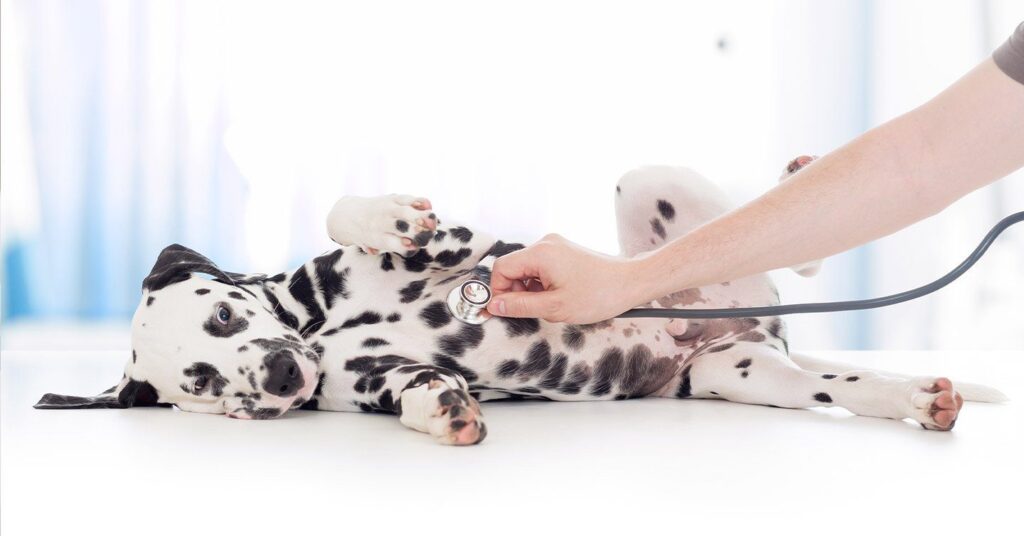
Once you’ve found a great vet, it’s time to book your first wellness appointment – and get your puppy vaccinated. While not insurance, Pumpkin’s Preventive Essentials Pack for Puppies is an easy optional add-on you can buy with your insurance plan to get a full refund for one wellness visit exam fee in the first year, any four puppy vaccines you and your vet choose, and one fecal “poop” test to screen for intestinal worms. This can make it easier to plan and pay for routine wellness expenses your puppy needs.
Here’s what to remember on your first veterinary visit:
- Bring all your paperwork from any prior veterinary visits your puppy may have had. You may need to acquire these from your puppy’s rescue, shelter, or breeder, depending on where you got them.
- Let your vet know what food you’re feeding your puppy, as well as what treats and any and all supplements you may be giving them.
There are also other procedures your puppy may need, Dr. Woodnutt advises. “Depending on your pup’s worming regime up to now, they may also need worming. I generally advise worming pups every two weeks until they are 12 weeks old, but this varies between regions depending on disease risks,” she says. “Flea and tick prevention may also be necessary, depending on your area and the time of year.”
For a wellness visit, Dr. Claudine Sievert, DVM, says you can expect your vet to check in on the following for your puppy:
- Body condition (joints, muscles, and body weight)
- Movement of the pup
- Auscultate the lungs and the heart for any birth defects
- Skin and the hair for external parasites such as ticks, fleas, and lice
- Ear canals and eyes
- Visibility and hearing tests
- Lymph nodes to see if there is any sign of infection
10. License and microchip your pet.
If your puppy ever gets loose or lost – a fate we don’t wish on anyone, but it happens to the best of us – a microchip will make it much more likely that you’re reunited with your canine companion. Though it’s not a feature of all pet insurance plans, Pumpkin Pet Insurance plans cover microchip implantation. Once your puppy is microchipped, register and license your puppy (methods vary by municipality, so check with your town or city), and be sure to include its chip number on your files.
11. House train your puppy.
Here comes the really hard stuff! House training a puppy isn’t easy, but it’s rewarding! Some house-training tips from Dr. Sievert:
- If you are considering getting a new puppy, having an older, well-behaved dog around can help a younger dog understand the rules of the household. Because dogs are pack animals, the older dog will naturally take the role of the pack leader, and the younger dog will mimic their behavior.
- Puppies eat four to five times a day. 10 minutes after their meal they usually have to go potty. That is when you need to put them on the potty pad. Use the same potty pad several times, so they can associate the smell with the action of peeing/pooping.
- Once they get their vaccinations, you can start taking them out after their meals. Walking will promote intestinal mobility and they will most likely poop. Make sure to have the same walking schedule every day.
12. Brace yourself for teething.
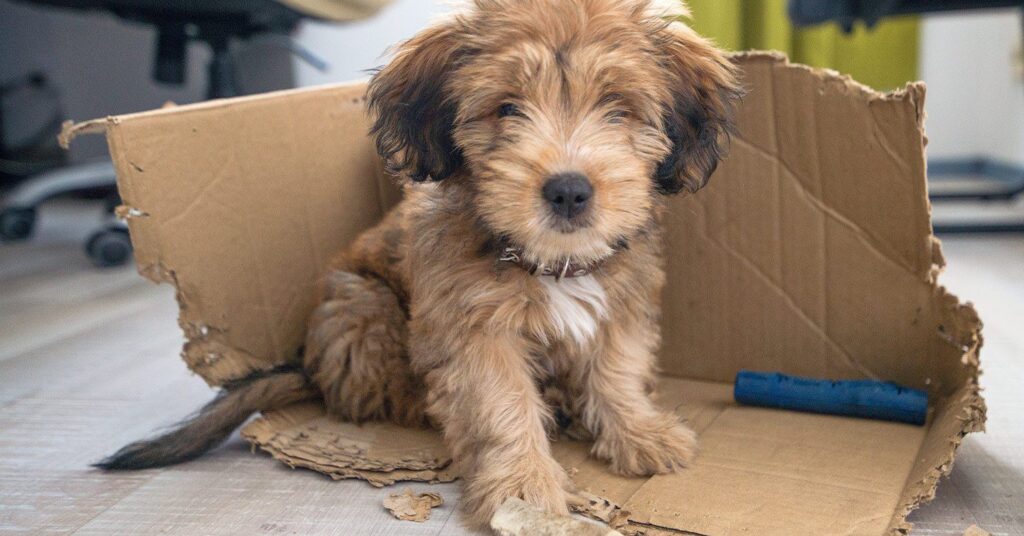
Teething puppies will chew on pretty much everything they can get their little paws on, so be sure to invest in anti-chew spray and keep items like shoes and anything else that may normally be within their reach away and out of sight. Not only will your favorite kicks have new chomps, your puppy could also ingest some not-so-savory stuff, resulting in choking and/or intestinal blockages that could require expensive surgery. Teething toys and treats can alleviate some of their discomfort (and the potential damage they could do to your property).
13. Begin puppy school.
Whether you work with a trainer, take your puppy to puppy school, or train your puppy yourself at home, it’s a good idea for them to socialize with other puppies and begin to learn bite inhibition and basic commands. The age to begin training can vary depending on the breed of your puppy, but a good list of basic commands to teach your puppy include sit, stay, come, down, and heel. These will help teach your puppy impulse control as well make them easier to walk, feed, and live with in general. If you’re working with a trainer, get recommendations from friends and family (or just check Yelp!). Do the same with puppy schools, but be sure they have all of their vaccines and boosters first if your puppy will be around other dogs. If taking a DIY approach to puppy training, positive reinforcement, patience, and treats will be your best friend!
13. Give your puppy their own space.
Crate training is invaluable, especially if your puppy will have to be alone at home at some point. Dr. Sievert recommends starting crate training as early as possible, but to take it slow. “Make your puppy play in and near the crate,” she recommends. “During the process of introducing him to a crate, use some treats to keep him motivated. Once he becomes comfortable being in the crate, you can extend the length of time he is in there.”
Length of time recommended for your puppy to be in their crate by age, from Dr. Sievert:
- 8–10 weeks: 30–60 minutes
- 11–14 weeks: 1–3 hours
- 15–16 weeks: 3–4 hours
- 17+ weeks: 4–5 hours
“At the age of 17+ weeks, your puppy can be kept in a crate for longer periods. But remember, this should never be a permanent solution – so, if you are not able to occasionally check on your dog during a day, this may not be the best option for you,” she notes.
That doesn’t mean you can’t have a social life without your puppy! You may just want to give your pup more space while you’re out for extended periods. “If your puppy is going to stay alone for more than a couple hours consider a ‘puppy zone,’” Dr. Sievert says. “Choose a secure area of your home. All you need to make a cozy puppy zone is baby gates, blankets, potty pads, and plenty of safe chew toys.”
14. Continue socializing your puppy.
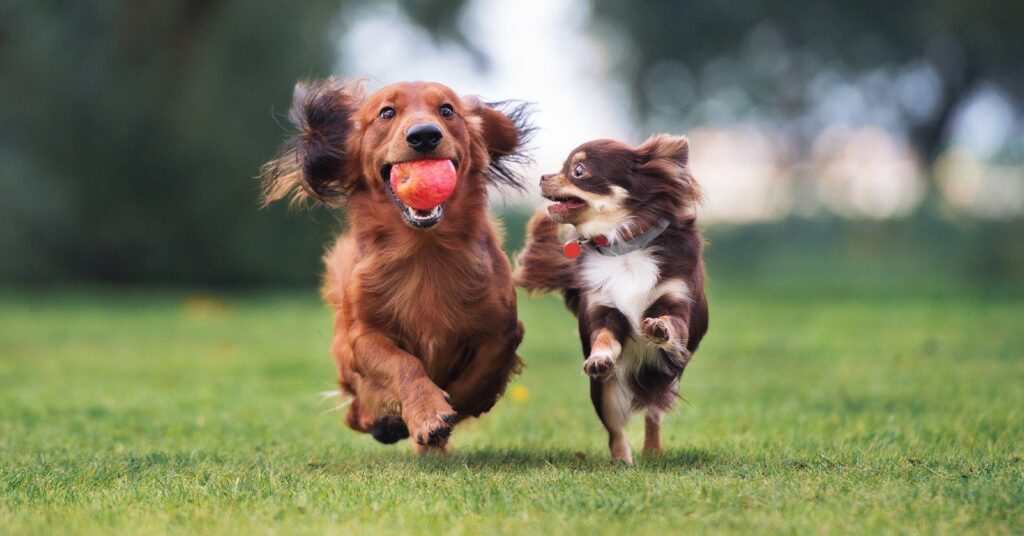
Once your puppy is fully vaccinated and has some basic dog training under their belt (er, collar!), it’s time to make friends! Socializing your fur baby with other sweet pooches is crucial to their development – and socializing a puppy is much easier than socializing an adult dog, so don’t skip out on this. Not only is it nice for dogs to make canine companions, it also helps test out their newly acquired bite inhibition. Some ways to introduce your puppy to playmates include:
- Changing up walking routes to meet new bark buddies (especially great for social distancing)
- Taking them to doggy daycare
- Setting up specific playdates with friends who have pets
- Taking them to dog runs and parks
It’s also important to socialize your puppy with people. Let them get to know some dog-loving friends and family members first. If possible, keep your circle diverse so your puppy gets comfortable with people of all different shapes, sizes, and ages. Keep treats handy so your puppy will make positive associations with their new hooman pals.
15. Show some puppy love.
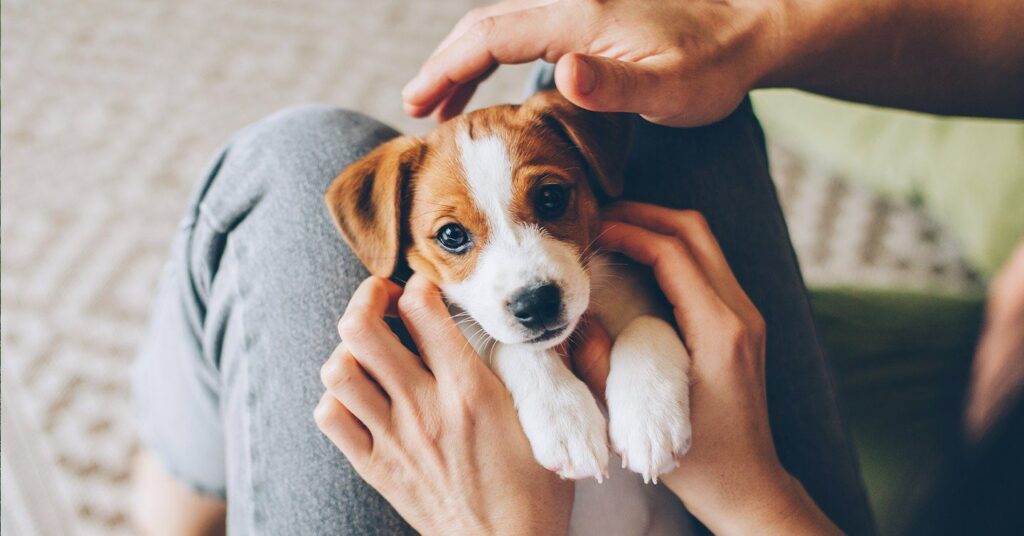
Your puppy will need time to acclimate to their new home, so be patient, affectionate, and compassionate if things aren’t easy at first, especially with a rescue puppy. “Give the dog three to four weeks to break out of their shell, become familiar with their new surroundings/routine, and to trust you,” Johnna Devereaux, Clinical Pet Nutritionist told Pumpkin. “They’ve been failed by humans before if they’re in a shelter!”
Deveraux also urges you to manage your expectations: Your puppy will become your best friend and a full-fledged member of your family, but it probably won’t happen overnight. “Not all dogs came from a good home the first time around and they need time to learn that you are going to be their furever home,” Deveraux says. “Trust them, love them, and treat them kindly! They’ve been through a lot!”
With this new puppy checklist, you’re set up to enjoy one of the most rewarding relationships you can have: Puppy love!
*American Pets Product Association, “2017-2018 APPA National Pet Owners Survey.” Estimated lifetime cost for a dog living 12 years based on annual spend data from survey (12 years at $1,386 per year).
Pumpkin Pet Insurance policies do not cover pre-existing conditions. Waiting periods, annual deductible, co-insurance, benefit limits and exclusions may apply. For full terms, visit pumpkin.care/insurancepolicy. Products, discounts, and rates may vary and are subject to change. Pumpkin Insurance Services Inc. (Pumpkin) is a licensed insurance agency, not an insurer. Insurance is underwritten by United States Fire Insurance Company, a Crum & Forster Company and produced by Pumpkin. Pumpkin receives compensation based on the premiums for the insurance policies it sells. For more details, visit pumpkin.care/underwriting-information.
All trademarks are the property of Pumpkin or a related company or licensor unless otherwise noted.
Copyright © 2021 Pumpkin Insurance Services Inc. All rights reserved.
